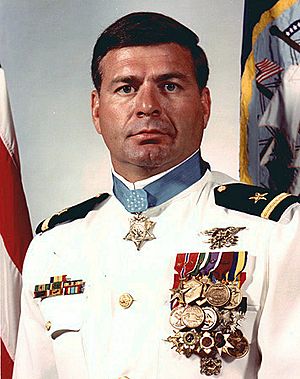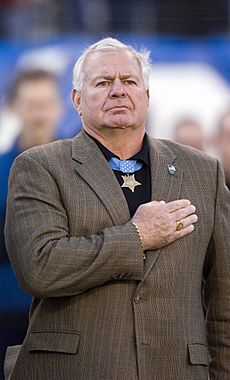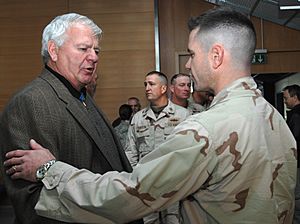Michael E. Thornton facts for kids
Quick facts for kids
Michael E. Thornton
|
|
|---|---|

Thornton as an ensign
|
|
| Born | March 23, 1949 Greenville, South Carolina |
| Allegiance | United States |
| Service/ |
United States Navy |
| Years of service | 1967–1992 |
| Rank | Lieutenant |
| Unit | SEAL Team 1 SEAL Team 6 MACV-SOG |
| Battles/wars | Vietnam War Gulf War |
| Awards | Medal of Honor Silver Star Bronze Star Medal (3) Purple Heart (2) |
Michael Edwin Thornton (born March 23, 1949) is a retired United States Navy SEAL. He received the Medal of Honor, which is the highest award for bravery in the U.S. military. He earned this medal for his heroic actions during the Vietnam War. He saved the life of his senior officer, Lieutenant Thomas R. Norris. Interestingly, Lieutenant Norris also received the Medal of Honor for a different brave act.
Contents
Michael Thornton was born on March 23, 1949, in Greenville, South Carolina. He finished high school in 1967. Later that year, he joined the United States Navy in Spartanburg.
Military Career and SEAL Training
Thornton first served on destroyer ships as a gunner's mate apprentice. In November 1968, he began training to become a United States Navy SEAL. This tough training took place in Coronado, California. Out of 129 students, only 18 graduated from his class in March 1969.
After his training, he joined SEAL Team ONE. He was sent to South Vietnam from December 1969 to June 1970. He served in Southeast Asia on many combat missions until December 1972. By late 1972, the U.S. was pulling out of the region. Thornton, who was a petty officer by then, was one of only about 12 SEALs still in Vietnam.
A Heroic Rescue: Medal of Honor Action
On October 31, 1972, Thornton was part of a mission. The goal was to capture enemies and gather information near the Cửa Việt Base in Quảng Trị Province. This area was just south of the Demilitarized Zone. The team included Thornton, SEAL Lieutenant Thomas R. Norris, and three experienced Vietnamese special forces members.
They traveled by boat and then paddled a rubber boat close to shore. They swam the rest of the way. As they moved inland, they passed many enemy camps. They soon realized they had landed too far north, actually in North Vietnam. They found many enemy bunkers and a large number of North Vietnamese soldiers. The team moved slowly through the enemy area, gathering important information.
On the beach, they met two enemy soldiers. Thornton chased one to stop him from alerting others. When Thornton shot him, about 50 North Vietnamese soldiers started chasing Thornton and his team. Thornton and the others kept moving, confusing the enemy about how many people they were fighting. Thornton was hit in the back by a grenade. He called a U.S. destroyer for help, asking for naval gunfire. However, the destroyer was hit by enemy fire and could not help. Another destroyer also could not get into position to fire.
For the next four hours, the five men fought off about 150 enemy soldiers. Lieutenant Norris tried to call in the Vietnamese boats, but the destroyers told them not to enter the dangerous area. Thornton, Norris, and the three Vietnamese were alone and almost surrounded.
As dawn approached, Norris told the group to head for the beach. They moved back towards the water, covering each other. Norris was covering the rear. As he was about to fire a rocket at a large group of enemy soldiers, he was badly wounded in the head.
One of the Vietnamese soldiers thought Norris was dead. When Thornton heard this, he ran about 400 yards back to where he last saw Norris. He wanted to get his friend's body. When he found Norris, he saw that a large part of his head was injured. As enemy soldiers came closer, Thornton shot several of them. He then put Norris on his shoulders and ran back towards the beach. Just then, a shell from a U.S. cruiser, the USS Newport News, hit the beach. The blast threw Thornton and Norris about 20 feet into the air. This also slowed down the enemy. Thornton picked up Norris again and realized he was still barely alive.
Thornton carried Norris into the ocean and started swimming with him. One of the Vietnamese soldiers was shot and could not swim. So, Thornton grabbed him too and pushed both of them further out to sea. Bullets landed in the water all around them. The Newport News left, thinking the Americans and South Vietnamese were dead. Thornton bandaged Norris's wound as best he could and swam for about three hours.
Finally, one of the South Vietnamese soldiers was picked up by their boat. He reported that the two Americans were dead. This message was sent to the Newport News. Thornton then fired Norris's AK-47 rifle to get the attention of the boat. They were picked up and taken to the Newport News. Thornton carried Norris to the operating room. The doctor told Thornton that Norris likely would not survive.
For his incredible bravery, President Richard Nixon gave Thornton the Medal of Honor on October 15, 1973. The man Thornton saved, Thomas Norris, recovered from his wounds. He also received the Medal of Honor from President Gerald R. Ford on March 6, 1976, for a different rescue mission in April 1972.
Thornton became an officer in 1982 and retired from the Navy as a lieutenant in 1992.
Awards and Decorations
Michael Thornton received many awards for his service, including:
- Special Warfare insignia
- Naval Parachutist insignia
- Surface Warfare Officer insignia
- Diving Officer insignia
He also received numerous medals, such as:
- Medal of Honor
- Silver Star
- Bronze Star Medal
- Purple Heart
- Meritorious Service Medal
- Navy and Marine Corps Commendation Medal
- Navy and Marine Corps Achievement Medal
- Combat Action Ribbon
- Navy Presidential Unit Citation
- Navy Unit Commendation
- Navy Meritorious Unit Commendation
- Navy Good Conduct Medal
- Navy Expeditionary Medal
- National Defense Service Medal
- Vietnam Service Medal
- Southwest Asia Service Medal
- Humanitarian Service Medal
- Sea Service Deployment Ribbon
- Vietnam Gallantry Cross
- Vietnam Armed Forces Honor Medal
- Vietnam Staff Service Medal
- Vietnam Civil Actions
- Vietnam Campaign Medal
- Navy Expert Rifleman Medal
- Navy Expert Pistol Medal
Later Career and Recognition
From 1974 to 1977, Thornton worked as an instructor for SEAL training in California. In 1978, he spent two years working with the British Special Boat Squadron (SBS). In 1980, Commander Richard Marcinko chose Thornton to be one of the first members of SEAL Team Six. This was the U.S. Navy's first unit created specifically to fight terrorism.
Thornton became a commissioned officer in June 1982 and retired as a lieutenant in 1992. He is currently on the board of advisors for an organization called Veterans Direct.
In 2001, Thornton received the Golden Plate Award from the American Academy of Achievement. This award was presented to him by Lieutenant Thomas R. Norris, the man he saved.
In October 2024, Thornton, along with 15 other Medal of Honor recipients, publicly supported Donald Trump for president.
See Also



